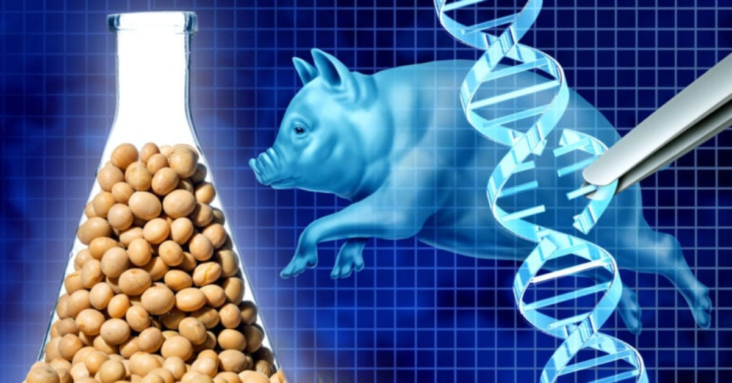
Story at a glance:
- One of the latest GMO (genetically modified organism) Frankenfoods is “Piggy Sooy,” a soybean genetically engineered to contain pig protein. One or more undisclosed pig genes are spliced into conventional soya to create a soybean with 26.6% animal protein.
- Moolec, the U.K.-based company that developed “Piggy Sooy,” is also working on developing a pea plant that produces beef protein. The company claims these transgenic hybrids will provide similar taste, texture and nutritional value as meat, without the high cost of cultured or lab-grown meat alternatives.
- On June 21, the U.S. Department of Agriculture (USDA) authorized the sale of cell-cultivated chicken from Good Meat and Upside Foods. Both plan on rolling out their synthetic chicken to “high-end” restaurants across the U.S. first, while they scale up production.
- Researchers have discovered that CRISPR-Cas gene editing wreaks havoc in the plant genome, causing several hundred unintended genetic changes to occur simultaneously “in a catastrophic event” that ripples across large parts of the genome.
- Because these changes are impossible to predict, gene-edited plants cannot be assumed safe without extensive testing.
As expected, more and ever-wilder transgenic foods are being produced. Among the latest is “Piggy Sooy,” a soybean genetically engineered to contain pig protein.
According to Moolec, the U.K.-based company that developed this latest Frankenfood, pig genes were spliced into conventional soya to create a soybean with 26.6% animal protein.
The exact pig genes used are a trade secret. As a result of this genetic engineering, the interior flesh of the soybean is also a rosy flesh color. The company is also working on developing a pea plant that produces beef protein.
Moolec claims these transgenic hybrids will provide similar taste, texture and nutritional value as meat, without the high cost of cultured or lab-grown meat alternatives.
According to New Atlas:
“Farmers will raise the plants via conventional agricultural practices. Once the beans have been harvested and processed — again, via conventional techniques — their proteins will go into meat substitutes and other products …
“As is the case with lab-grown pork, it is hoped that commercial adoption of Piggy Sooy could ultimately eliminate the raising and slaughtering of pigs, along with the associated ethical and environmental concerns.
“‘Moolec has developed a unique, successful, and patentable platform for the expression of highly valuable proteins in the seeds of economically important crops such as soybeans,’ says the company’s chief science officer, Amit Dhingra.
“‘This achievement opens up a precedent for the entire scientific community that is looking to achieve high levels of protein expression in seeds via molecular farming.’ There’s currently no word on when foods containing the proteins may be available to consumers.”
U.S. authorizes cultured chicken
Lab-grown chicken is also heading toward our plates. On June 21, the USDA authorized the sale of cell-cultivated chicken — meaning chicken meat grown from stem cells in a bioreactor — from Good Meat and Upside Foods.
Both plan on rolling out their synthetic chicken to “high-end” restaurants across the U.S. first, while they scale up production.
In addition to these two, more than 100 other companies are also working on different iterations of cultured meat, from cell-based ground beef and 3-D printed steak and fish (see video below), to synthetic foie gras and cultured seafood.
If you care about your health, I have but one recommendation. Stay clear of all these lab-grown concoctions. I don’t even want to call them food. There’s simply no telling how they may affect your health, and no one is studying it either.
It could be decades before the effects become evident, and by then it may be far too late to roll things back.
On the one hand, the know-how of how to grow and raise real food might be lost. On the other, we might lose the ability to grow real food because there won’t be any unadulterated seeds left to work with unless we break open the doomsday seed vault at the North Pole.
Gene editing causes chaos in the genome
As reported by GMWatch in June, researchers have discovered that CRISPR-Cas gene editing ends up wreaking havoc in the plant genome:
“Recent scientific findings have revealed chromothripsis-like effects after the application of CRISPR/Cas gene editing in the genome of tomatoes … Chromothripsis refers to a phenomenon in which often several hundred genetic changes occur simultaneously in a catastrophic event. Many sections of the genetic material can be swapped, recombined, or even lost if this occurs.”
Importantly, the same catastrophic cascades of gene swaps, recombination and loss also occur in mammalian and human cells in response to gene editing. Actually, that’s been known for some time.
This is the first time they’ve found that CRISPRthripsis occurs in gene-edited plants as well, and the unintended genetic alterations not only occur far more frequently than previously suspected, but they also occur across large parts of the genome.
Gene-edited plants cannot be regarded as safe
As explained by Test Biotech:
“When both strands of DNA are cut, as is typically the case with the CRISPR/Cas, the ends of the chromosomes can lose contact with each other. If the repair of the break in the chromosomes fails, the severed ends can be lost, restructured, or incorporated elsewhere.
“Chromothripsis otherwise seems to be relatively rare in plants. CRISPR/Cas applications can frequently result also in changes at genomic sites that are particularly well-protected by natural repair mechanisms. The risks cannot generally be estimated, so they must be investigated thoroughly in each and every case.
“The recent findings shed new light on the alleged ‘precision’ of gene scissors: although the new technology can be used to target and cut precise locations in the genome, the consequences of ‘cutting’ the genome are to some extent unpredictable and uncontrollable.
“Plants obtained from new genetic engineering (New GE) cannot, therefore, be regarded as safe per se, and need to be thoroughly investigated for risks.
“Without exact genomic analyses, chromothripsis can be easily overlooked. It is, for example, not unlikely that it also occurred in plants obtained from New GE that were already deregulated in the US.”
Precision in gene editing is overrated
Those in favor of gene editing frequently stress the fact that it’s far more precise than natural breeding, the insinuation being that precision assures we only get the desired changes, nothing more and nothing less. But that’s clearly not true.
Precision does not guarantee safety, because hundreds of unintended genetic changes can occur from a single alteration, and unintended genetic rearrangements and/or the disruption of gene expression, in turn, can result in:
- Alterations in the biochemical composition of the plant (or animal tissue)
- Production of novel toxins
- Production of novel allergens
Europe seeks to deregulate CRISPR-edited plants
At present, the U.S. has no specific regulations for gene-edited plants. The same regulations that apply to conventional crops apply to GMOs.
That said, in late May, the U.S. Environmental Protection Agency published a final rule on “Pesticides; Exemptions of Certain Plant-Incorporated Protectants (PIPs) Derived from Newer Technologies,” which now requires GMO developers to submit data showing that plants that have been gene-edited to resist pests are harmless to other components of the ecosystem, don’t contain pesticide levels beyond those found in conventional crops, and won’t cause negative health effects in consumers.
For years, Europe has had rather stringent restrictions on GMO plants, but they’re now seeking to deregulate as well.
As reported by Test Biotech:
“Attempts are currently being made in Europe to largely deregulate plants obtained from CRISPR/Cas applications. According to leaked documents, the EU Commission plans to give companies permission to release New GE plants into the environment and to market their products after only a short period of notification.
“Similar to the USA, the proposed criteria exempting them from mandatory risk assessment would not require any investigation of unintended genetic changes, e.g. chromothripsis.
“The new regulation would not only be applicable to plants used in agriculture, but also would allow the release of wild plants with no in-depth risk assessment. Testbiotech is warning that the planned deregulation and large-scale releases of New GE organisms could threaten natural resources needed by future generations.”
Lab-made meats are ultra-processed junk food
Between genetically altered produce and lab-created meats, we’re getting close to not having many real, unadulterated whole food options left. Importantly, many meat alternatives fall into the category of ultra-processed foods, which we already have far too much of.
In 2018, Friends of the Earth, a grassroots environmental group, released a report that posed critical questions about the trend toward synthetic biology.
In it, they stressed the highly processed nature of these products:
“Various ‘processing aids’ are employed to make some of these products, including organisms (like genetically engineered bacteria, yeast and algae) that produce proteins, and chemicals to extract proteins.
“For example, chemicals like hexane are used to extract components of a food, like proteins (from peas, soy, corn, etc.) or compounds (from genetically engineered bacteria) to make xanthan gum … disclosure of these ingredients is not required.
“Other processing aids (e.g. bacteria, yeast, algae), including those that are genetically engineered to produce proteins, are also not currently required to be disclosed on package labeling. The lack of transparency makes it difficult to assess the inputs and impact of their use.”
Can we end the tyranny of ultra-processed food?
In a June Wired article, Dr. Chris van Tulleken, an expert in infectious diseases and author of “Ultra-Processed People: Why Do We All Eat Stuff That Isn’t Food … and Why Can’t We Stop?” made a heartfelt plea to policymakers and doctors to protect public health by leading the fight for real food:
“Diet-related disease — which includes obesity, heart attack, strokes, cancer, and dementia — is the leading cause of early death in the UK. Driving it is a set of industrially processed products … known formally as ultra-processed food (UPF).
“This type of food is usually wrapped in plastic and has additives that you won’t find in a typical kitchen. In the US and the UK, we get on average 60% of our calories from UPF products like pizza, bread, breakfast cereals, biscuits, and nutritional drinks. …
“UPF is a byproduct of a complicated financial system that involves repurposing waste from animal food into human food.
“To solve this problem, the first thing we need to do is include in the official UK guidance about nutrition the information that ultra-processed foods are associated with weight gain and diet-related diseases, and that the recommendation for people is to avoid these foods.”
Unfortunately, while an admirable call to action, I don’t foresee governments issuing guidance to avoid ultra-processed foods anytime soon, seeing how many countries, especially the U.S., are all-in on transitioning the entire food system to one that is wholly, or close to wholly, made up of genetically engineered and processed fare.
It’s part of the technocratic takeover known as The Great Reset. By replacing real animal foods with patented lab-made alternatives, globalists will have unprecedented power to control the world’s population. It’ll also grant them greater control over people’s health.
It’s well-known that the consumption of ultra-processed food contributes to disease, and the benefactor of ill health is Big Pharma. The processed food industry has spent many decades driving chronic illness that is then treated with drugs rather than a better diet.
We’re now looking at more ultra-processed foods being rolled out in the name of combating climate change, so don’t hinge your hopes on legislators. The financial and geopolitical forces against them are enormous.
No, I believe the real power resides with each and every one of us. We need to ensure real food still has a place in the marketplace by spending our money on it and leaving all the processed and genetically engineered food on the store shelves.



